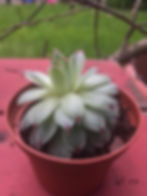The Power of Sunlight: Why Your Succulent Needs to Be in the Sun
- Succulent Garden
- Sep 24
- 3 min read

Sunlight is the single most crucial factor in keeping your succulent healthy and happy. While these plants are famous for being low-maintenance, a lack of light can quickly lead to a weak, sickly, and unattractive plant. Here’s a detailed look at why sun exposure is so important, how to spot a sun-deprived succulent, and what you can do to fix it.
WHY IS SUNLIGHT SO IMPORTANT FOR SUCCULENTS?

Succulents are native to sunny, arid regions around the world. Their biology is perfectly adapted to store water and use sunlight efficiently to thrive. Without enough light, the plant can't perform photosynthesis, the process of converting light energy into the food it needs to grow.
Compact Shape: Proper sunlight keeps the plant's rosettes and stems tight and compact. This is what gives succulents their iconic, beautiful shape.
Vibrant Color: Many succulents, like Echeveria and Graptoveria, develop beautiful, vibrant colors when exposed to adequate sunlight. This "stress coloring" is a natural defense mechanism that makes the plant even more stunning.
Strong Growth: A sun-deprived plant will have weak, fragile stems and leaves, making it vulnerable to pests and diseases. Sunlight ensures the plant's cell walls are strong and resilient.
WHAT ARE THE SIGNS OF A SUN-DEPRIVED SUCCULENT?
Your succulent will always tell you if it's not getting enough sun. Here are the most common signs to watch for:
Stretching (Etiolation): This is the most obvious sign. The stem will become long and leggy, and the leaves will be spaced far apart as the plant stretches to reach for a light source. The beautiful, compact rosette will be gone.

Pale or Faded Color: The vibrant colors that once adorned your plant will begin to fade, and the leaves will turn a pale green. This is a sign that the plant is not producing enough chlorophyll.

Drooping Leaves: The leaves may begin to point downwards instead of upwards, as if they are too heavy or weak to stand up straight. This is another result of a weak stem.

HOW TO FIX A SUN-DEPRIVED SUCCULENT
If your succulent is showing signs of stretching, it's time to act. Unfortunately, the long, leggy growth will not go away on its own.
Step 1: Gradually Increase Sunlight Exposure

Do not move your plant from a dark corner directly into full, harsh sun. This will cause sunburn, which appears as white or black patches on the leaves. Instead, gradually introduce it to more light over a period of a week or two. Start with a few hours of bright, indirect light, and slowly move it to a sunnier spot.
Step 2: Prune the Leggy Stem
The stretched part of the stem will not revert to its compact shape. The best way to fix this is to prune or "behead" the plant.
Using a clean, sharp knife, cut the stem a few inches below the healthy rosette of leaves.

You can then replant the top part of the cutting in fresh, well-draining soil. This will encourage new roots and new growth.

Don't throw away the remaining stem! New baby plants (pups) will likely sprout from the nodes along the stem.

Step 3: Provide a Consistent Light Source

Once your plant has recovered, make sure it has a consistent source of light. A south-facing window is ideal. If that's not possible, consider a grow light to ensure your succulent always gets the energy it needs to stay healthy and beautiful.



